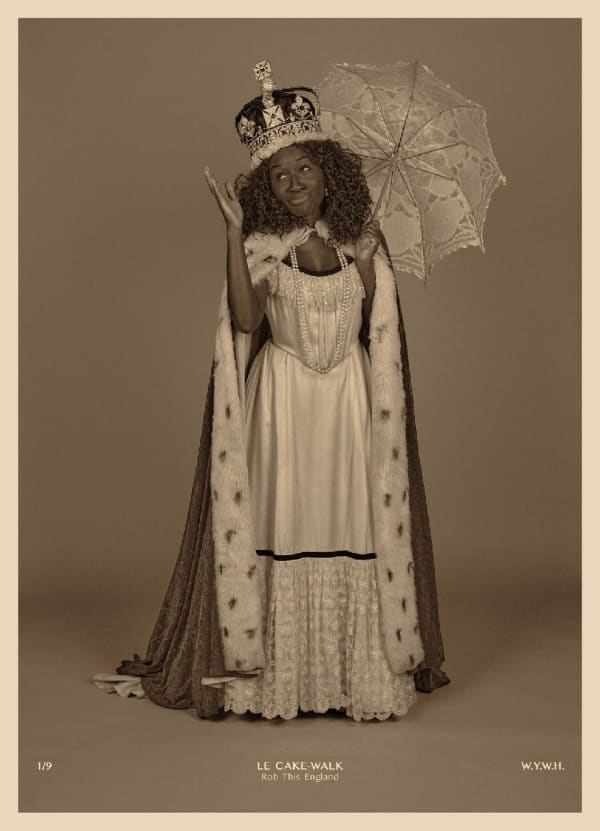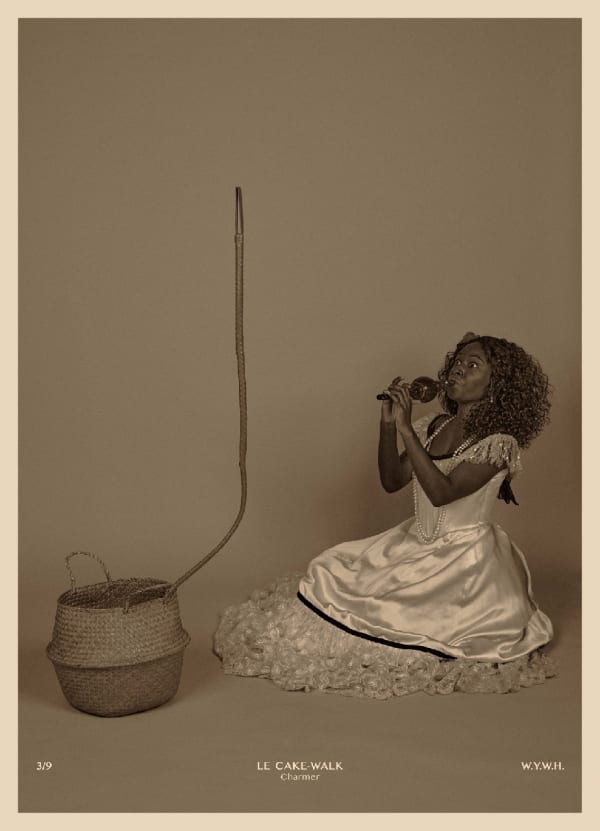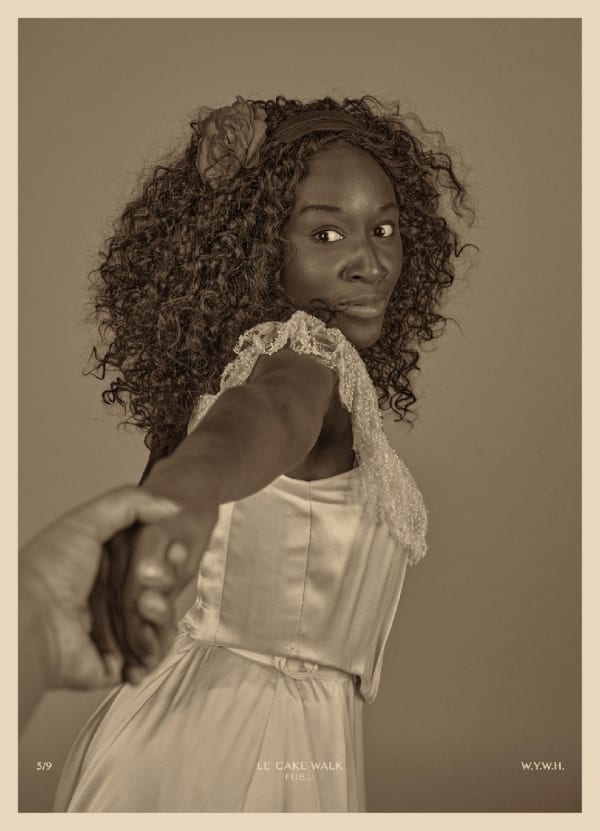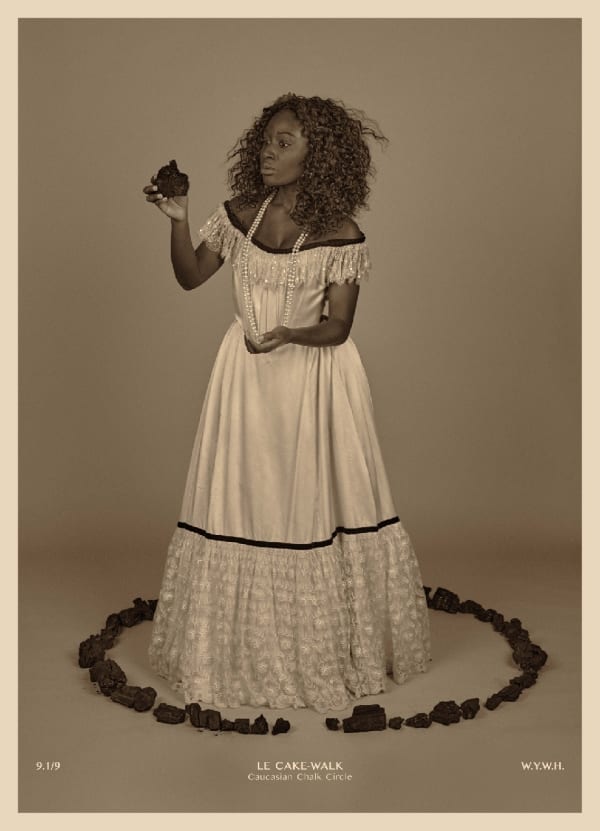-
The Hyman Collection is delighted to have commissioned Heather Agyepong's new series of work, Wish You Were Here (2020).
Artist's Statement:
Unless we learn the lesson of self-appreciation and practice it, we shall spend our lives imitating other people and deprecating ourselves. - Aida Overton Walker
Wish you were here focuses on the work of Aida Overton Walker, the celebrated African American vaudeville performer who challenged the rigid and problematic narratives of black performers. She was known as the Queen of the Cake-Walk which was a dance craze that swept America & Europe in the early 1900s. The Cake-walk was originally performed by enslaved people who mocked and mimicked the slaveholders and high society. The dance involved couples in square formations, strutting, prancing and high kicking. It is unclear whether the slave holders understood the connotation but nevertheless enjoyed the performances so much that they held contests for the performers. -
After emancipation, this dance grew in popularity. It continued to be performed in dance contests by African Americans to white audiences , with the best performers awarded cake.
The dance was adopted in minstrel shows, seen as a low art form by white audiences. But in 1902 things changed. Aida Overton Walker reinterpreted the dance into one of elegance, skill and accuracy in her performance in In Dahomey. She received acclaim and praise for her rendition and soon became the 'queen of the cakewalk'. She became so famous that she performed at Buckingham Palace in 1903 for Prince of Wales's 9th birthday where she taught high society how to do the famous dance. Although she was limited in freedoms and expressions, she was very outspoken in how she wanted to be represented. She challenged the status quo depicting black women as cultural producers and drew attention to the limiting embodiments of her status as a performer.
During the turn of the century postcards depicting Cake-Walk dancers were distributed around Europe, especially in France, where negrophilia was taking over the Avant Garde. The postcards were often grotesque and offensive with the allure of spectacle where the performers lacked agency.
Wish you were here uses the figure of Overton-Walker to re-imagine these postcards as one not of oppression but of self-care with a mandate for people of Afro-Caribbean descent to take up space. The images explore the concepts of ownership, entitlement and mental wellbeing. By embodying Overton-Walker as guide, ancestor and advocator, the series uses satirical commentary and depictions of radical self-worth in an attempt to disrupt the roadblocks affecting our collective mental health.
The project was commissioned by The Hyman Collection, London.
Special thanks to Thom Bridge, Stella-Jane Odoemelam & Neve Marinou for all their assistance. -
-
 Heather Agyepong, Wish You Were Here (1. Le Cake-Walk: Rob This England), 2020
Heather Agyepong, Wish You Were Here (1. Le Cake-Walk: Rob This England), 2020 -
 Heather Agyepong, Wish You Were Here (2. Le Cake-Walk: Razzle Dazzle), 2020
Heather Agyepong, Wish You Were Here (2. Le Cake-Walk: Razzle Dazzle), 2020 -
 Heather Agyepong, Wish You Were Here (3. Le Cake-Walk: Charmer), 2020
Heather Agyepong, Wish You Were Here (3. Le Cake-Walk: Charmer), 2020 -
 Heather Agyepong, Wish You Were Here (4. Le Cake-Walk: The Body Remembers), 2020
Heather Agyepong, Wish You Were Here (4. Le Cake-Walk: The Body Remembers), 2020 -
 Heather Agyepong, Wish You Were Here (5. Le Cake-Walk: F.U.B.U.), 2020
Heather Agyepong, Wish You Were Here (5. Le Cake-Walk: F.U.B.U.), 2020 -
 Heather Agyepong, Wish You Were Here (6. Le Cake-Walk: Spotlight on Rest), 2020
Heather Agyepong, Wish You Were Here (6. Le Cake-Walk: Spotlight on Rest), 2020 -
 Heather Agyepong, Wish You Were Here (7. Le Cake-Walk: B***h Better), 2020
Heather Agyepong, Wish You Were Here (7. Le Cake-Walk: B***h Better), 2020 -
 Heather Agyepong, Wish You Were Here triptych (8.1. Le Cake-Walk: Anna Mae), 2020
Heather Agyepong, Wish You Were Here triptych (8.1. Le Cake-Walk: Anna Mae), 2020 -
 Heather Agyepong, Wish You Were Here triptych (8.2. Le Cake-Walk: Anna Mae), 2020
Heather Agyepong, Wish You Were Here triptych (8.2. Le Cake-Walk: Anna Mae), 2020 -
 Heather Agyepong, Wish You Were Here triptych (8.3. Le Cake-Walk: Anna Mae), 2020
Heather Agyepong, Wish You Were Here triptych (8.3. Le Cake-Walk: Anna Mae), 2020 -
 Heather Agyepong, Wish You Were Here diptych (9.1. Le Cake-Walk: Caucasian Chalk Circle), 2020
Heather Agyepong, Wish You Were Here diptych (9.1. Le Cake-Walk: Caucasian Chalk Circle), 2020 -
 Heather Agyepong, Wish You Were Here diptych (9.2. Le Cake-Walk: Caucasian Chalk Circle), 2020
Heather Agyepong, Wish You Were Here diptych (9.2. Le Cake-Walk: Caucasian Chalk Circle), 2020
-












